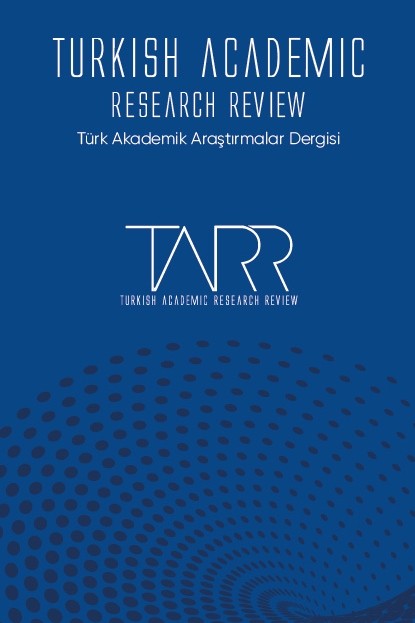J.G. Ballard’ın The Drowned World Romanının Ekofeminist Okuması
J.G. Ballard 20. yüzyılın en etkili İngiliz yazarları arasındadır. Gerçeküstü eserleriyle tanınan Ballard, iklim kurgunun önde gelen örneklerine imza atmıştır. The Drowned World J.G. Ballard’ın felaket sonrası dörtlemesinin ikinci romanıdır. Roman, küresel çapta bir sel felaketi esnasında bir bilim insanının hayatta kalabilme mücadelesini anlatmaktadır. Buna ek olarak, Londra’da hayatta kalan ve romanın da tek kadın karakteri olan Beatrice Dahl dikkat çekmektedir. Bu bağlamda, ekofeminizm, feminist düşünce ile ekoeleştiri kuramını bir araya getiren kapsamlı bir teoridir. The Drowned World romanı Beatrice karakteri aracılığıyla sosyal ekofeminizme ait kavramları bünyesinde barındırmaktadır. Makale, Beatrice Dahl karakterine odaklanarak, The Drowned World’ü sosyal ekofeminist pencereden analiz etmeyi amaçlamaktadır. Böylece, ataerkil kapitalizm ile kadınların maruz kaldıkları baskılar arasındaki ilişki romana yapılan göndermelerle açığa çıkarılmaktadır.
Anahtar Kelimeler:
J.G. Ballard, , Ekofeminizm, , The Drowned World, İklim Kurgu, Karen J. Warren, Apokaliptik Kurgu
An Ecofeminist Interpretation of J.G. Ballard’s The Drowned World
J.G. Ballard is one of the most influential British authors of the 20th century. Renowned for his surrealist works of fiction, Ballard delivered the primary examples of climate fiction. The Drowned World is J.G. Ballard’s second novel of a post-apocalyptic quadrilogy. The novel tells the story of a scientist’s quest for survival amidst a global flood. Moreover, Beatrice Dahl happens to be the only woman left alive in London and the sole woman character of the novel itself. To that end, ecofeminism is a comprehensive theory which combines feminist thought with the school of ecocriticism. The Drowned World is a novel that incorporates notions of social ecofeminism through the character of Beatrice. This article aims to provide a social ecofeminist analysis of Ballard’s The Drowned World by focusing on the character of Beatrice Dahl. All in all, the relationship between patriarchal capitalism and the oppression of women and nature is exposed in the article with specific references to the novel.
Keywords:
J.G. Ballard, Ecofeminism, The Drowned World, Climate Fiction, Karen J. Warren, Apocalyptic Fiction,
___
- Alonso, I. S. (2013). Redefining humanity in science fiction: The alien from an ecofeminist perspective [Doctoral dissertation]. https://core.ac.uk/download/pdf/58910906.pdf
- Ballard, J. G. (2010). The drowned world (15th Edition). HarperCollins.
- Batrićević, A., & Paunović, N. (2019). Ecofeminism and environmental security. Facta Universitatis, Series: Law and Politics, 17(2), 125-136. https://doi.org/10.22190/fulp1902125b
- Bennett, B. (2005). Through ecofeminist eyes: Le Guin’s “The ones who walk away from Omelas”. English Journal, 94(6), 63. https://doi.org/10.2307/30046506
- Bookchin, M. (1980). Toward an ecological society. Black Rose Books.
- Buran, S. (2020). An identity of one’s own: Feminist ideology and identity crisis of an academic woman in a postmodern feminist fiction. Söylem Filoloji Dergisi, 5(2), 605-628. https://doi.org/10.29110/soylemdergi.780898
- Clement, T. (2016). Finding a hidden heroine in J.G. Ballard’s sci-fi novel, The Drowned World. In Peer Reviewed Proceedings of the 7th Annual Conference Popular Culture Association of Australia and New Zealand (PopCAANZ) (pp. 61-68). Massey University.
- Ekmekçi, Ç. (2019). Female body politics: “The Powerful Female Body” in mythological stories. RumeliDE Journal of Language and Literature Studies, (5), 209-214. https://dergipark.org.tr/tr/download/article-file/786376
- Hemmanti, M., & Röhr, U. (2009). Engendering the climate change negotiations: Experiences, challenges and steps forward. In G. Terry (Ed.), Climate change and gender justice (pp. 155-168). Oxford.
- Holmes, C. (2016). Ecofeminism. Australian Feminist Studies, 31(87), 111-113. https://doi.org/10.1080/08164649.2016.1175054
- King, Y. (1995). The ecology of feminism and the feminism of ecology. In M. H. MacKinnon & M. MacIntyre (Eds.), Readings in Ecology and Feminist Theology (pp. 150-159). Rowman & Littlefield.
- Klemmer, C. L., & McNamara, K. A. (2019). Deep ecology and Ecofeminism: Social work to address global environmental crisis. Affilia, 35(4), 503-515. https://doi.org/10.1177/0886109919894650
- Kümbet, P. (2012). Ekofeminizm: Kadın, Kimlik, Doğa. In S. Oppermann (Ed.), Ekoeleştiri, Çevre ve Edebiyat (pp. 171-206). Phoenix Yayınları.
- Liu, Y. (2021). An interpretation of the Ecofeminism in the grapes of wrath. Proceedings of the 6th Annual International Conference on Social Science and Contemporary Humanity Development (SSCHD 2020), 517, 215-219. https://doi.org/10.2991/assehr.k.210121.045
- Orr, L. (2000). The utopian disasters of J.G. Ballard. CLA Journal, 43(4), 479-493. https://www.jstor.org/stable/pdf/44325010
- Shiva, V., & Mies, M. (2014). Ecofeminism. Zed Books Ltd.
- Warren, K. J. (1997). Ecofeminism: Women, culture, nature. Indiana University Press.
- Warren, K. J. (2000). Ecofeminist Philosophy: A western perspective on what it is and why it matters. Rowman & Littlefield.
- Wu, Y. (2020). The analysis of Elsa’s growth from the perspective of ecofeminism. Open Journal of Social Sciences, 08(06), 30-36. https://doi.org/10.4236/jss.2020.86003
- Öztürk, M. Y. (2020). Ekofeminizme genel bir bakış: Kadınlar, doğa ve hiyerarşiler. The Journal of Academic Social Science Studies, 13(81), 705-714.
- Yayın Aralığı: Yılda 4 Sayı
- Başlangıç: 2016
- Yayıncı: Mehmet ŞAHİN
Sayıdaki Diğer Makaleler
Yetişkinlerde Dindarlık ve Psikolojik Dayanıklılık İlişkisi
Covid-19 Hastalığını Geçiren Sağlık Çalışanlarının Başa Çıkma Sürecinde Din Ve Maneviyat
Cezaî Sorumluluk Bağlamında İkrah ve Hukuki Sonuçları
Osmanlı Medrese Müfredatında Felsefe Kaldırıldı mı?
Eugène Ionesco’nun Gergedanlar Oyununda Gergedanlaşma
Abbasî Beytü’l-Hikmesi İle Ağlebî Beytü’l-Hikmesi’nin Karşılaştırılması
Manzum Bir Osmanlı Kroniği Olan Silkü’l-Le’âl-i Âl-i Osmân’ın Kaynakları
Mezhebî Aidiyetler Bağlamında Mu‘tezile’nin Arap Dilini Kullanımı
Grice’in Teorisi Açısından Kamûs-ı Keşânî Destânı’nın İncelemesi
